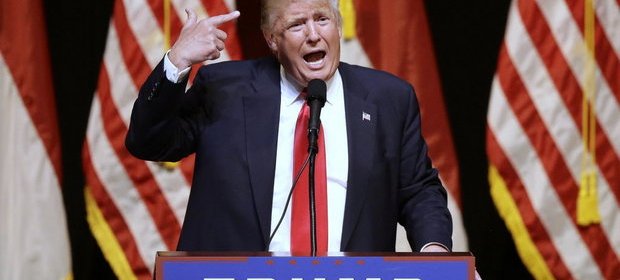A series of filing anomalies point to a Donald Trump camp that is either unaware of campaign finance law, or is actively funneling donors’ cash to insiders, according to several experts interviewed by CNBC.
These “red flags,” as one expert deemed them, include a total lack of disclosure on which vendors staffers for the presumptive Republican nominee are paying, an “unusual” six-figure payout to campaign staff for nontaxable expenses and what appeared to be double reimbursements for some employees’ expenses.
When asked about the apparently unusual filing practices, Trump spokeswoman Hope Hicks said in an email that “the report speaks for itself.”
But experts said that message was not entirely clear, and at the very least broke with long-established protocols — something that would be entirely keeping in character for one of the most surprising campaigns in the modern era.
“In my view, the situation is significant if (what) we are seeing is a pattern that reflects serious problems with the campaign,” Larry Noble, general counsel of the Campaign Legal Center who also worked for 13 years as Federal Election Commission general counsel, told CNBC. “If the report is speaking for itself, it’s not saying anything coherent.”
The Campaign Legal Center is a nonpartisan, nonprofit watchdog organization that works with the courts and federal agencies to enforce and defend campaign finance laws. The center recently filed a complaint with the FEC against the Trump campaign for its solicitation of money from foreign nationals and politicians.
Who is getting paid?
Of particular note, Trump’s FEC filings raised questions on just which vendors campaign staffers were paying for out of their own pockets (and then later receiving reimbursements).
According to the filings, campaign staffers are routinely reimbursed for these “in-kind” purchases of office supplies and other expenses. In-kind payments are normal for campaigns, but are supposed to be followed by the name of any vendors used.
“Just like the FEC informed the campaign in November: When the campaign pays a single vendor more than $200 during the election cycle, the name of the vendor should be disclosed, even if a staff person is making the purchase on behalf of the campaign,” Noble said.
He added that as far as he could tell, “there is no indication of who the vendors are for the in-kind services.”
This omission is likely to elicit inquiries from election officials, according to multiple experts.
“It is reasonable to expect that the Feds will be asking questions; the answers will determine whether this is record-keeping sloppiness or something more, the magnitude and significance of which right now is unknown,” said Jacob Frenkel, a partner at Dickinson Wright and a former federal criminal prosecutor of Federal Election Campaign Act violations and public corruption.
“Areas of focus will be who owns the vendors and whether they are at all affiliated with the candidate, and whether information not yet disclosed needs to be made public,” he added.
Obviously, it is legal for a campaign to use vendors associated with the candidate, but such payments require disclosure.
This is not the first time transparency surrounding the Trump campaign’s filings has been a potential issue. The Reports Analysis Division of the FEC, which audits campaign filings, issued a letter to the campaign on Nov. 15, 2015, requesting disclosure on payroll and cash disbursements to Trump Payroll Corp. and Trump Tower Commercial LLC that are in the campaign’s October quarterly report. Trump refiled his amended report on Dec. 17, 2015. After reviewing the amended report, CNBC called the FEC, which said it is not currently investigating any Trump presidential campaign filings.
In that letter, a representative from RAD explicitly informed the campaign that it needed to disclose vendor information when payments exceeded $200.
Driving up costs?
Another question raised by the lack of specific payment descriptions is the campaign’s reimbursements for staffers’ “mileage” — payments which are not taxed. If those figures provided by the Trump team are actually for personal vehicle depreciation and expenses, experts said they point to a wholly unrealistic amount of travel. If the “mileage” payments are for air or some other measurement of travel, they said, it would be a potentially never-before-seen use of the system.
Since its July 2015 quarterly filing, the Trump campaign has disbursed 239 nontaxed mileage payments to 82 individuals for a total of $237,555.30, and those payments “raise a lot of questions,” according to Noble.
Paid campaign staff often rent cars when travelling, Noble said, so these payments suggest that people are driving their own cars and driving a tremendous number of miles every day.
“The number of staff being reimbursed mileage and the overall amount of travel being reimbursed appears unusual,” he said.
Noble explained to CNBC that those submitting mileage must include a log of the miles driven, but Trump’s FEC filings did not appear to include any such logs along with the paperwork for payment. For comparison, the 2012 campaign for GOP nominee Mitt Romney and the 2016 campaign for presumptive Democratic nominee Hillary Clinton did not record any mileage payments.
One example is the disbursement to one Heather Fox, whose name matches a Mississippi Trump field operative, but whose address is given as the campaign’s New York headquarters. She received a single payment of $4,269.45 (nontaxable) from the campaign on May 19, 2016. Because there were no logs attached to the report, CNBC was unable to determine the amount of miles Fox drove and the period in which she traveled that distance.
Since the IRS currently pays 54 cents a mile, the filing implies that she traveled more than 8,000 miles — what would be a lot of driving for a state operative. “That payment doesn’t appear to make sense,” Noble concluded.
According to CNBC research, the most mileage payments were given to Trump advance staffer Gavin Smith. He received 12 payments totaling $8,114.29 between July 2015 and May 2016. The most money for mileage went to one Mark Lloyd (whose name matches the campaign’s Virginia director, but whose address was also listed as the New York headquarters) at $13,862.
Tax attorneys who asked not to be named told CNBC that taxpayers are frequently aggressive when adding up their miles for such payments because it is money that is not taxed.
Double payments?
The Trump camp’s handling of so-called contribution refunds also sparked questions. All Trump staffers who logged “in-kind” purchases were both reimbursed for those costs and also appeared to receive a second payment in the form of a campaign contribution refund.
In addition to representing a second payment, this practice raises questions because contribution refunds are normally for donors who exceed their legally defined limits, not paid staffers, multiple experts told CNBC.
That second staffer refund “does not make sense,” Noble said.
A total of $23,315 in campaign contribution refunds were given to Trump staffers between his February and June FEC filings.
For example, New Hampshire State Director Matthew Ciepielowski filed $2,068.23 for “in-kind” office supplies and was subsequently reimbursed in May. But in a second filing for individual campaign refunds, Ciepielowski was refunded for $2,068 (the only difference between the two entries was the dropped change in the contribution refund).
All staffer individual campaign refunds were logged the same way — the dollar amount for contribution refunds was identical to the “in-kind” repayments without the cents.
Noble confirmed CNBC’s findings, adding that the apparent double payments are “a red flag.”
“Instead of paying a campaign staffer for a purchase or service, the campaign is treating the expense as an in-kind reimbursed contribution. If that sounds confusing, that is because it is,” campaign law compliance attorney Kenneth Gross of Skadden, Arps, Slate, Meagher & Flom said. “Perhaps there is a good reason for it but I have not seen this before. I don’t know why the campaign would do it this way.”
Importantly, Gross said, this method of payment “has the net effect of giving the appearance that the campaign is receiving more donations than it is even though the cash on hand works out in the final analysis. It is not pernicious but it is certainly awkward.”
In fact, the majority of campaign contribution refunds were doled out to Trump staffers. In the May filings, for example, there were at least 11 payments made to staff members — seven of which went to Ciepielowski — out of 13 total refunds that month. Clinton’s camp, by comparison, recorded more than 1,700 contribution refunds in its corresponding report. CNBC is currently reviewing questions about Clinton’s filings, and further reports will be forthcoming. The filings for the Hillary Clinton presidential campaign are approximately five times larger than the Trump campaign’s.
Out of all the contribution refunds, Ciepielowski received the most money, bringing in $7,199 — all tax free. CNBC reached out to Ciepielowski, Fox, Lloyd and Smith but only Fox responded. She told CNBC that, at first, the campaign required her to keep logs and maps detailing her road trips and that she had to send them into the campaign in order to get paid. “I was never offered a car. I did not know if it could have been an option. I have worked on campaigns before and this campaign did not have standard campaign practices.”
“I worked literally the entire state as well as traveled to other states to help get the vote out for other primaries,” Fox explained. “In traditional campaigns you just focused on your own districts you were hired to focus on.” Fox told CNBC she traveled to Baton Rouge, Little Rock, as well as driving more than 200 miles one way to pick up campaign supplies.
CNBC asked Trump spokeswoman Hicks for further clarification on the double payment anomalies to see if it was a clerical error on all of the FEC filings or if Trump campaign staffers were indeed paid twice, but Hicks did not respond.
But does it matter?
Frenkel said that “red flags,” such as those potentially identified in Trump’s filings are considered “smoke” for investigators, and it’s up to the agencies to see if it is smolder or there is fire.
“It is much too early to tell if this may lead to a criminal investigation, but (the information detailed in this report) justifies the FEC and possibly the IRS trying to determine what is behind these findings in the campaign’s public disclosure documents,” Frenkel said.
“Whether these are issues for the individuals, if they are receiving double or improper payments, or for the campaign if there are improper reimbursements, that information only can become known by drilling down into the payments to each person and the attendant circumstances,” he added.
Bob Biersack, senior fellow at the Center for Responsive Politics, called Trump’s reports “complex, and in some ways they look more complicated than they need to be,” after reviewing the documents. Examples of this included the possible double payments and the fact that the campaign regularly omits memos describing vendor payments and mileage, he explained.
(h/t CNBC)
Reality
Donald Trump also raised red flags when courting donations from foreign politicians.











